From 1864, it has seen it all
Lined by Dutch cannons strategically placed to ward off returning Portuguese fleets, the mile-long promenade by Colombo’s sea front was the favoured spot for the colonial gentry ‘to take in the air’.
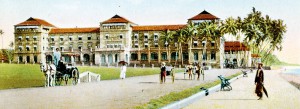
The way it was: Galle Face Hotel in its early days
It was British Governor Sir Henry Ward who commissioned the Galle Face Green, as we know it, in the late 1850s. Earlier the Green had sprawled over a much larger expanse with horse races being held there until they were moved to Colombo’s Race Course in the early 1800s.
Like the Green it overlooks, Galle Face Hotel’s stately façade is an integral part of Colombo’s landscape and one that has morphed with time.
As the historic hotel last month proudly unveiled its refurbished interiors with the management’s vision focused on restoring some lost grandeur, one of the hotel’s newly installed resident historians Sandali Matharage walked us through from past to present.
A team of British entrepreneurs constructed the Galle Face Hotel on the Green’s Southern end in 1864 where a Dutch building housing ammunition for their cannons and the soldiers manning them had once stood.
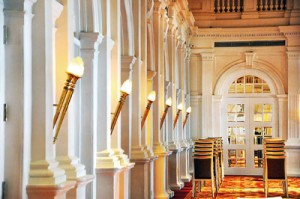
Vintage touch: Torch lamps light the con servatory. Pix by Indika Handuwala
The Dutch structure called “Galle Face House” was completely torn down, says Matharage, and rising in its place was “What we call the Hotel’s North Wing” designed by renowned architect Thomas Skinner.
Prior to the Suez Canal’s opening in 1869, the hotel had only consisted of the North Wing but shorter travel times saw a greater influx of visitors brought in by the ships calling at Colombo and the “South Wing” was built in 1890 to meet this demand.
The verandah runs across the building’s length, opening up to an arrestingly regal pillared porch which has seen the likes of Rudyard Kipling, Pope John Paul II and Steven Spielberg pass through.
Where once horse-drawn carriages bearing the Galle Face Hotel crest drew up, today taxis wait outside the same low walls hoping for a guest in need of a quick ride.
Vintage photographs of the main entrance show some notable changes during the 1960’s -70’s. Glass panelled doors were replaced by thick wooden ones with ornate oriental carvings.
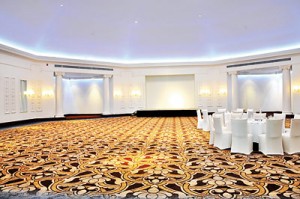
If these walls could speak: The Coconut Room, now the Jubilee Room has witnessed many a rollicking party from yesteryear
The balustrade trimming a terrace over the porch was substituted by “something resembling tiles”.
“Originally there weren’t any majestic carved doors,” says Matharage explaining that in their place stood elegantly framed glass, with no local elaborations.
“There’s been significant streamlining of added frills which don’t seem evident in the few pictures of the hotel’s original interior. We have many pictures of the outside, but not as much of the inside.”
A colour photograph is how they discovered that the Galle Face Hotel was actually pink, Matharage says. The rosy hue owing to building materials used is now covered under layers of plaster.
Legendary parties are said to have been hosted in the “Coconut Room”. Famously known by that name in the early 1900s, the room had witnessed New Year’s Eve parties particularly during WWII that had even drowned out the sound of air raid sirens.
“Luckily it was just a drill and the band played on,” she smiles. In the 60’s the Coconut Room played host to talent searches like Radio Star Ceylon, hosted by Vernon Corea.
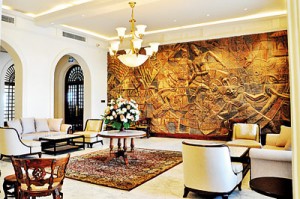
Local touch: Tissa Ranasinghe’s terracotta mural installed in 1970 now in full view at one end of the lounge
It was here that the Jetliners were discovered and the band went on to record their first album in the lobby. Minus dated tapestry trailing down from the skylight, today this space is called the Jubilee Ballroom.
No colonial hotel is complete without a grand ballroom. Before renovations guests could peer down into Galle Face Hotel’s grand ballroom from the balconies but these have now been sealed off to keep noise from echoing throughout the hotel.
Between the two renowned venues is what we’re told is “the Conservatory” which serves as an extended foyer to both ballrooms. Brass torch-like lamps resembling the original lamp-shades found in the dining room are new additions here.
Time has invariably muffled much that went on inside the Galle Face Hotel. Reports of a spa run by two sisters in one of the rooms, fail to mention where their establishment was in fact located.
Another shot in the dark for the staff was to assume records of a sport “enjoyed by both men and women” was a reference to croquet. Guests are soon to receive instructions on how to play the game as the hotel recently inaugurated its own “The Colombo Croquet Club.”
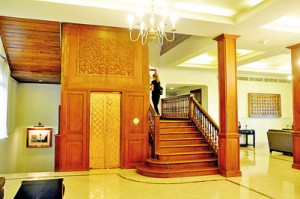
The South Wing: Wood panels and Otis elevator
The Sri Lankan touch is seen in the lobby where artist Tissa Ranasinghe’s large terracotta mural installed in 1970 depicting multi-ethnic worship in the country, previously visible over the former front desk, is now in full view at one end of the lounge.
The former smoking-lounge complete with wood panelled screen doors where Arthur C.Clarke is said to have penned the final chapters of his Space Odyssey trilogy isn’t included in the in-house tour.
But here behind the screen door is another ‘find’ from the 1940’s – an incomplete mural of brightly coloured dancers and fresh green foliage by Russian artist Alexander Sofronoff.
Connecting the North and South Wings is the black and white corridor synonymous with the Galle Face Terrace where countless cups of afternoon tea have been savoured.
Old photographs suggest that initially this was the restaurant itself, overlooking a larger lawn. Now the restaurant has grown, occupying more lawn-space.
The Southern Wing not used to capacity for the past 50 years has “a different feel to it” our guide shares. “We discovered that the elevators first installed in 1890 were manufactured by Otis, the same brand we use to date.”

Attention-grabbing exhibit in the museum: The cannon ball
Today its wood-toned interior houses guest rooms, a library featuring works of all celebrity guests and a museum in the conference area where plaques with familiar faces – former 007s, sportsmen, Olympic athletes, celebrated politicians, revolutionaries, clergy, royalty, explorers and authors who have visited the hotel stare back at you.
Next to the china “imported from the UK” imprinted with each modification of the hotel’s logo, a particular exhibit catches our attention.
The cannon ball sitting on a velvety bed has a curious tale. Misfired by a soldier in training, it had sailed through the hotel’s roof landing on the ground and rolling under a table around which a family was enjoying breakfast.
Thankfully it failed to detonate. It is a potent reminder that the Galle Face Hotel has seen it all and still stands strong.


